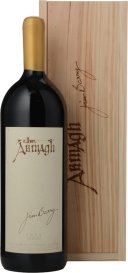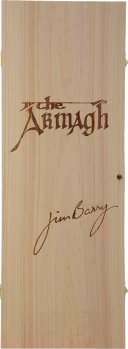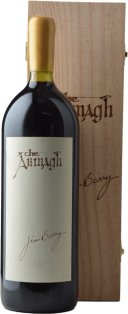Henschke Mount Edelstone Shiraz Collector's Edition Wooden Box 6-Pack
The prestigious Australian winery Henschke has remained a family-owned establishment for over 153 years and six generations. Situated in Keyneton, South Australia, within the esteemed Eden Valley wine region, Henschke proudly stands as a distinguished member of Australia's First Families of Wine. Since its inception in 1862, when Johann Christian Henschke planted a modest vineyard in Keyneton, the Henschke family has continuously crafted exceptional wines, forging a legacy of excellence with vineyards in the Eden Valley, Barossa Valley and Adelaide Hills, including acclaimed single-vineyards, Hill of Grace and Mount Edelstone. The fifth-generation winemaker Stephen Carl Henschke and his viticulturist wife Prue took over the operation of the winery in 1979 and they are recognised around the world for their exceptional quality wines, innovative spirit, focus on restoring native vegetation, organic and biodynamic practices in the vineyard. Johann Stephen Henschke, the eldest of Stephen and Prue’s three children has become the sixth generation member of the Henschke family since 1983. With the background of higher education in wine making, viticulture and oenology, Johann is now based at the family winery as winemaker and viticulturist while playing an important role of transferring his skill set and knowledge from the fifth to sixth generation. As the next generation prepares to navigate the well-documented challenges that lie ahead, Johann recognizes the indispensability of innovation and meticulous strategic planning. However, amidst these considerations, he firmly believes in upholding the time-honoured winemaking techniques that have been cherished by the Henschke family for generations. By ensuring that the legacy of Henschke is nurtured with the same prudence and care as it has always been, Johann and his peers can pass on a heritage that will endure and command the same esteemed reputation that it enjoys today. Henschke's commitment to excellence and sustainable wine production has garnered well-deserved recognition and accolades. In 2021, the winery was honoured as the Wine Enthusiast New World Winery of the Year, a testament to their exceptional craftsmanship and dedication to pushing the boundaries of winemaking in the New World. Furthermore, Henschke was also named the Winery of the Year by the prestigious Halliday Wine Companion, solidifying their position as a leader in the industry. Additionally, Henschke's unwavering commitment to sustainability and environmentally conscious practices has been acknowledged with the prestigious Robert Parker Wine Advocate Green Emblem. This recognition highlights their remarkable efforts in reducing environmental impact while producing outstanding wines. Henschke's unwavering pursuit of excellence and dedication to sustainable practices make them a true icon in the world of wine. The beautiful and historic name Mount Edelstone is a translation from the German Edelstein meaning ‘gemstone’, a reference to small yellow opals once found in the area. The Mount Edelstone Vineyard was planted in 1912 by Ronald Angas, a descendant of George Fife Angas who founded The South Australian Company and played a significant part in the formation and establishment of South Australia. Unusual for its time, the vineyard was planted solely to shiraz. The ancient 500-million-year-old geology in the vineyard has given rise to soils that are deep red-brown clay-loam to clay, resulting in low yields from the dry-grown, ungrafted centenarian vines. First bottled as a single-vineyard wine in 1952 by fourth-generation Cyril Henschke, by the time Cyril purchased the vineyard from Colin Angas in 1974, Mount Edelstone was already well entrenched as one of Australia’s greatest shiraz wines. Crafted by the Henschke family for over 60 years now, Mount Edelstone is arguably the longest consecutively-produced, single-vineyard wine in Australia. A moderately wet winter combined with average spring conditions meant that the vines grew well in the mild weather. Ideal flowering conditions in late spring/early summer led to the potential for near average yields. Late December became warm and dry, ensuring healthy canopies with low disease pressure. The summer months of January and February were typically warm and dry, characterised by above average overnight temperatures. The old-vine vineyards coped well with the warm nights, their deep roots able to withstand the warming and drying effect on the topsoil, maturing the balanced crops as autumn approached, March and April provided light and warmth to the Eden Valley which led to full and balanced maturity being achieved across all grape varieties. With warm sunny days and cool nights, the dry autumn guaranteed that pristinely healthy grapes arrived in the fermenters. All in all, the 2018 vintage will be considered a standout of the decade. Shiraz was certainly one of the highlights of the season, fittingly so in the year we celebrated our 150th anniversary of family winemaking. Henschke Mount Edelstone Shiraz 2018 vintage was matured in 27% new and 73% seasoned (77% French, 23% American) oak hogsheads for 20 months prior to blending and bottling. Best served at 17°C. In the correct conditions, this wine could be cellared for 35+ years from vintage. Deep ruby with ruby hues, Spicy, complex and dark fruited aromas of blackberry, dark red plum and blueberry, with sage, bay leaf, thyme, anise, black pepper, nutmeg and cedar. A rich, plush and beautifully integrated palate offers layers of spicy dark fruits, pepper, sage, musk and clove, balanced by bright acidity, cxcellent depth and long and elegant fine, velvety tannins
Jim Barry The Armagh Shiraz
Elegant and aristocratic kaleidoscope of aromas, an abundance of fruit flavours, blackberry, mulberry and blueberry with supporting complexity of mint, eucalypt, rhubarb, Turkish delight and cinnamon. The palate offers a rich tapestry of enjoyment and fulfilment of flavours of raspberry, strawberry and boysenberry to name a few. Made by Jim Barry.
Thibault Liger-Belair Les Saint Georges 1er cru
THIBAULT LIGER-BELAIR Les Saint Georges 1er cru, Nuits-St-Georges
Domaine Lucien Le Moine Grand Cru
Château Ausone Saint-Émilion Grand Cru
Dalla Valle Vineyards Maya Cabernet Cabernet Franc
Chateau Palmer 3me cru classe
Regarded a Super Second (but technically a 3me growth), Palmer is capable of producing wines that equal or even outstrip the quality of its famous Premier cru neighbour, Ch. Margaux. Named for the wealthy English military man who bought the estate in the early 19th century, Palmer is now majority owned by the Mahler Besse and Sichel families - famous Bordeaux negociants. Many of the best plots on the property were purchased after the Classification of 1855, explaining in part why Palmer did not warrant higher standing at that time. Certainly today there is no question that the wine is among Bordeauxs best. The estate also makes a separate second label - named Alter Ego - which is made from similarly high quality fruit but treated differently in the winery with the aim of producing a counterpoint in style to the First wine.
Chateau Mouton-Rothschild 1er cru classe
One of the very greatest estates of Bordeaux, Château Mouton Rothschild is in the commune of Pauillac in the Haut-Medoc, 50km north-west of the city of Bordeaux. Its Chateau wine or grand vin is among the worlds most highly-rated and expensive. Excluded from the highest rank (Premier Cru or First Growth) of the famous Bordeaux Classification of 1855, Mouton was finally promoted in 1973 after decades of lobbying by Baron Philippe de Rothschild, who ran the estate from 1922 until his death in 1988. Mouton was first in the region to bottle at the estate, rather than shipping its wine to merchants for bottling elsewhere. Since 1924 artists including Braque, Dali, Picasso, Henry Moore, Miro, Chagall, Kandinsky, Andy Warhol, Francis Bacon, David Hockney and Lucian Freud have been commissioned to produce label images. Mouton, uniquely among the First Growths, remains in the hands of the same family as it was at the time of the 1855 Classification. The vineyards are on slopes with gravel-based soils leading down to the Gironde estuary and total 75ha 80% Cabernet Sauvignon, 16% Merlot, 3% Cabernet Franc and 1% Petit Verdot. The Chateau wine is (unusually) fermented in large oak vats and then matured in new oak barrels for between 19 and 22 months. Total production of the grand vin is 20,000 dozen or less. There is a second wine, Le Petit Mouton, established in 1993. The grand vin is noted for its flamboyance exotic, powerful aromas of cassis, minerals, tobacco leaf and graphite, an opulent palate and impressive length of flavour.
CHATEAU HAUT BRION 1er cru classe
Chateau Haut Brion is one of the five first Growths of the 1855 Classification of the Medoc. The Chateau was established in 1533 by Jean de Pontac, who was the first to plant vineyards on this prime gravelly site, found in the Graves sub-region of Pessac Leognan. The Chateau is owned today by Prince Robert of Luxembourg, the great grandson of Clarence Dillon. It is planted to Cabernet Sauvignon, Merlot, Cabernet Franc and Petit Verdot, with three hectares planted to the white varieties of Semillon and Sauvignon Blanc. Chateau Haut Brion is the only property outside of the Medoc in the 1855 classification. A wine of class and breed, Chateau Haut Brion is typically more approachable in its youth, showing floral perfume and elegance, yet possesses the structure required for exceptional longevity.
Chateau Lafite-Rothschild 1er cru classe
One of the most famous - as well as one of the most expensive - wines in the world, Chateau Lafite Rothschilds history dates back to 1235, by which time, it is believed, the vines were already planted and thriving. Nearly 1,000 years later it still retains the name of its then-owner Gombaud de Lafite. It wasnt until 1868 that the Rothschilds came to become the Chateaus owners, after it was sold at public auction in Paris - and it remains in their hands today. Producing an elegant Paulliac wine, Chateau Lafite is renowned for its characteristic blend of rich dark fruit with spicy, savoury and earthy notes of cassis, tobacco, and truffle. The 2016 earned sterling reviews, with James Suckling scoring it a perfect 100 and speculating on its standing as Perhaps the greatest Lafite since the legendary 1959.
























































